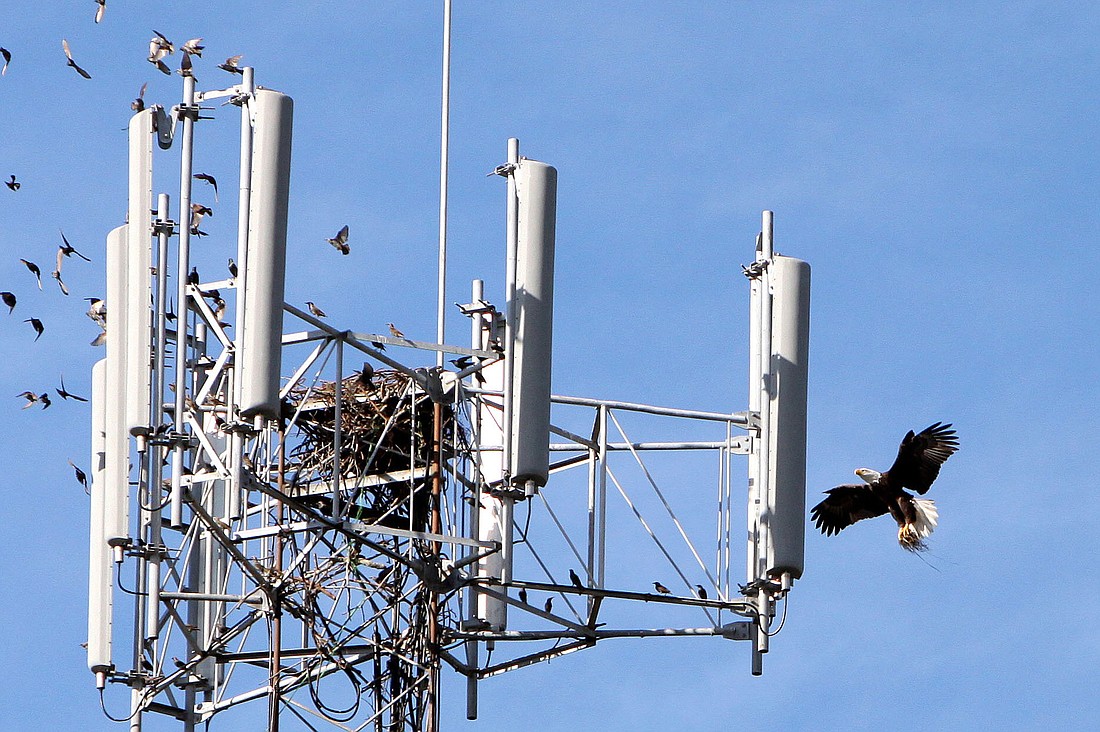- October 19, 2022
-
-
Loading

Loading

Ed Smith Stadium’s resident bald eagles have survived.
In 2010, the eagles’ previous nest built atop the right field ballpark lights was removed by wildlife officials and destroyed to make way for the $31 million stadium renovation.
And Monday, a few weeks after their arrival for the winter breeding season, the pair survived the threat of a fire that destroyed a building close to their new nest, which is nestled atop a tall, metal cell-phone tower one block north of the stadium.
Last winter, the eagles relocated to the cell-tower nest — which is actually an old nest abandoned by the eagles years ago — just north of the stadium. The eagle pair has returned to the same nest for this breeding season.
Monday’s two-hour fire did not result in any human injuries, but it destroyed the Overhead Garage Door building off 12th Street and billowed black smoke into the air.
“Fortunately (the eagles) don’t have any young in the nest yet, so they will probably just leave and come back (when the air is clear),” said Dale Nauman, volunteer coordinator for the Sarasota and Manatee County branch of the Audubon EagleWatch.
Northeasterly winds blew most of the smoke away from the nest, according to fire officials at the scene. And the nest was not damaged during the fire.
Prior to the fire, the eagle pair had been fishing in nearby lakes and preparing their nest atop the tower just north of the ballpark. Nauman was optimistic the eagles would return to their nest-preparing activities in a few days.
Back home
Last Thursday, on a cool evening before dusk, one of the eagles circled overhead before landing with a talon-full of twigs. After dropping off the nest-building supplies, the eagle stood guard on its perch above the nest.
There is no way to tell for certain, but it is likely that these are the same eagles who were kicked out of the their nest built in the stadium lights, because eagles return to the same breeding ground year after year, said Nauman, who has been tracking eagles for 15 years.
“They got evicted, but the birds have learned to adapt,” Nauman said.
Although there are about 40 nests throughout the county, the cell-tower nest is the only known eagle nest within city limits.
In 2010, officials from Sarasota County and the Florida Fish and Wildlife Commission took the unusual step of removing two eggs from a nest that two bald eagles built in the right field light tower at the stadium.
After taking the eggs for incubation, workers tore down the nest and put up metal mesh to block the visibly upset adult eagles from landing on the lights again. Wildlife officials said they were trying to encourage the nesting pair to find a safer place to build another nest and possibly lay additional eggs.
“It wasn’t really an ideal place for them to be, with hot lights and everything,” Nauman said. “The (cell) tower isn’t an ideal spot, either. I’d rather see them in a tree with no one around.”
Nauman said county and state officials had to go through a lengthy permitting process to prove why they wanted to move the nest atop the ballpark lights.
“That was an unusual case,” Nauman said. “They had to go through a lot of permitting to do that. Their case was that it was good for the birds. But, of course, they had to get the stadium built.”
When the eagles moved to the tower, they actually returned to an older, abandoned nest they had used two winters before officials destroyed the nest in the ballpark lights.
The cell tower is located just north of the ballpark and to the west of the stadium’s overflow parking lot, with fishing waters available at several nearby small lakes and Sarasota Bay less than a mile away.
“They are picking this area because there is food,” Nauman said. “About three-quarters of their diet is fish.”
Bill Duffy, walking along Euclid Street past the nest on his way to the Sarasota Humane society, where he volunteers, said he has seen both adult eagles at the nest.
“Around August I started to see them again,” Duffy said.
Eagles mate for life and build nests that can reach 10 feet across and weigh up to a half a ton. The birds migrate great distances, but they usually return to breeding grounds within 100 miles of the place where they were raised.
Jan Thornburg, public information officer with the city, drives by the nest on her way home from work.
Recently, Thornburg has seen an eagle perched atop the tower, or landing down with a fresh catch from nearby ponds. She has nicknamed the eagle “Eddie,” for its preference for the grounds of Ed Smith ballpark.
In March, Thornburgh saw one of the eagles with a big fish in its talons.
“I was really excited when I realized they were back,” Thornburg said.
Tower nests
The tower nests bring hardships for the birds of prey.
Nauman has worked closely with the phone company to ensure that workers maintaining the tower don’t disturb the nest during nesting season.
“They need to be left alone,” Nauman said.
The eagle seen last week carrying twigs for the nest is a positive indication that the nest could hold eggs sometime in November, Nauman said.
A 30-day incubation period follows, and in another 12 weeks the fledglings would be ready to fly.
Nauman said it will be clear when the nest has eggs, because — through binoculars or a long camera lens — an eagle will be visible in the nest; a white head will be “there constantly.”